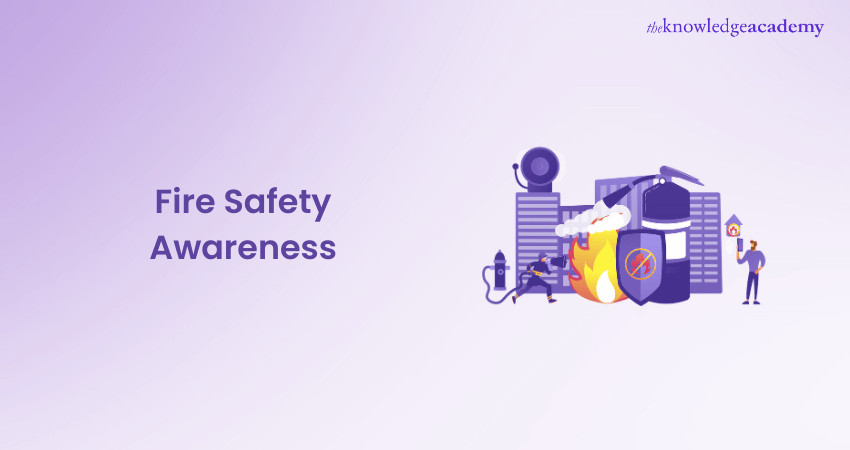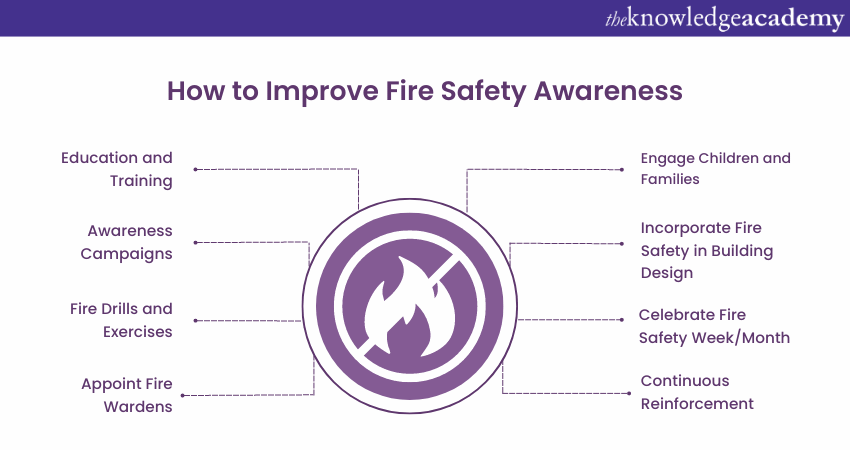We may not have the course you’re looking for. If you enquire or give us a call on +27 800 780004 and speak to our training experts, we may still be able to help with your training requirements.
Training Outcomes Within Your Budget!
We ensure quality, budget-alignment, and timely delivery by our expert instructors.

Fire Safety Awareness is crucial to maintaining a safe environment in homes, workplaces, and public spaces. Understanding the importance of Fire Safety, recognising potential fire hazards, and knowing how to respond in emergencies can save lives and prevent significant property damage.
According to Statista, in the UK, there were 334 fire-related fatalities in Great Britain during 2021/22, 23 more than in the previous reporting year. Increased Fire Safety Awareness has played a vital part in this. However, if you aren’t already aware of this essential approach, it’s time to learn about it. Read this blog to learn about Fire Safety Awareness, its objectives, and the essential steps to ensure Fire Safety in various settings.
Table of Contents
1) What is Fire Safety Awareness?
2) The Objectives of Fire Safety Awareness
3) Essential Components of Fire Safety Awareness
4) What Should be Done if There’s a Fire?
5) How to Improve Fire Safety Awareness?
6) Conclusion
What is Fire Safety Awareness?
Fire Safety Awareness is a comprehensive understanding of fire-related risks, including valuable Fire Safety Tips, prevention measures, and appropriate responses during fire emergencies. It goes beyond merely knowing how to use fire extinguishers; it involves being vigilant and proactive in identifying potential fire hazards to create a safer environment.
At its core, Fire Safety Awareness means recognising the various sources of fire hazards, such as faulty wiring, flammable materials, or improper storage of chemicals. By being aware of these risks, individuals can take the necessary precautions to minimise the likelihood of fire incidents.
Furthermore, basic Fire Safety Awareness involves educating people about preventive measures. This includes the following:
a) Understanding the safe use of electrical appliances
b) Proper storage of flammable substances
c) The significance of smoke alarms and fire sprinklers
d) How to respond promptly and effectively during a fire emergency
e) Evacuation procedures
f) Locating fire exits
g) When and how to use Fire Safety equipment like fire extinguishers or fire blankets
Moreover, timely and appropriate responses during a fire can save lives and prevent the situation from escalating. By following these safety practices, individuals can significantly reduce the chances of fires breaking out. By being informed and prepared, people can work together to minimise fire risks and ensure a safer living and working environment for everyone.

The Objectives of Fire Safety Awareness
Fire Safety Awareness campaigns must be conducted with the following objectives in mind:
1) Preventing Fire Incidents: The primary objective of spreading Fire Safety Awareness is to prevent fires from occurring in the first place. By educating individuals about potential fire hazards and promoting safe practices, you can significantly reduce the likelihood of fire accidents.
2) Minimising Fire Damage: In the unfortunate event of a fire outbreak, Fire Safety Awareness aims to minimise property damage and potential injuries. Understanding the proper use of Fire Safety equipment can help contain a small fire before it escalates.
3) Ensuring Prompt Evacuation: Another vital goal of Fire Safety Awareness is to educate people on the importance of swift and orderly evacuation during a fire emergency. Knowing the evacuation routes and assembly points can save lives.
4) Creating a Safety Culture: Fire Safety Awareness fosters a culture of safety where individuals take responsibility for their actions and surroundings. A well-informed community can work together to identify risks and implement preventive measures.
Essential Components of Fire Safety Awareness
The following make up the essential components of being aware of Fire Safety:
1) Identifying Fire Hazards: The first step in Fire Safety Awareness is to recognise potential fire hazards. Fire hazards may include the following:
a) Faulty electrical wiring
b) Flammable materials
c) Improper storage of chemicals
d) Even careless smoking
Regular inspections and risk assessments are essential to identify and address these hazards.
2) Fire Prevention Education: Educating individuals about fire prevention measures is critical. This includes educating about the following:
a) Safe handling of electrical appliances
b) Proper storage of flammable substances
c) The importance of smoke alarms
d) Fire sprinklers
Simple actions like not overloading power outlets can significantly reduce the risk of fire.
3) Fire Safety Equipment Training: Knowing how to use Fire Safety equipment effectively is crucial. Training should include the following:
a) Instructions on operating fire extinguishers
b) Fire blankets
c) Fire hoses
Regular drills can reinforce this knowledge and build confidence in dealing with fire emergencies.
4) Emergency Evacuation Plans: Establishing clear evacuation plans is essential for any building or facility. These plans should include the following:
a) Well-marked escape routes
b) Exit signs
c) Designated assembly points
Regular evacuation drills ensure that occupants know what to do in case of a fire.
5) Fire Safety in the Workplace: Employers should take the lead in promoting Fire Safety Awareness in the workplace. Conducting Fire Safety workshops, appointing fire marshals, and providing training to employees are all crucial aspects of workplace Fire Safety.
Take the first step towards safeguarding your environment with our Fire Extinguisher Training – Join now!
What Should be Done if There’s a Fire?
In the event of a fire, swift and decisive actions are crucial to ensure the safety of individuals and minimise potential harm. Here are essential steps to take if there's a fire:
1) Stay Calm:
Maintaining composure is crucial for clear thinking and practical action during a fire emergency. Panic hinders rational decision-making.
2) Activate Alarms:
Swiftly triggering fire alarms alerts others and initiates emergency response procedures, ensuring a quick and organised evacuation.
3) Evacuate Promptly:
Calm and quick evacuation using designated routes is essential. Avoiding elevators enhances safety during a fire escape.
4) Crawl if Necessary:
In the presence of smoke, staying low minimises inhalation of toxic fumes, enhancing chances of safe evacuation.
5) Feel Doors:
Before opening doors, use the back of your hand to check for heat. If it is hot, find an alternate route to avoid potential danger.
6) Use Fire Extinguishers:
If trained and it's safe to do so, use fire extinguishers on small, controllable fires. Remember the PASS method: Pull, Aim, Squeeze, Sweep.
7) Assist Others:
Help those who may struggle to evacuate, prioritising both their safety and yours during the process.
8) Assemble at Designated Areas:
Gathering at pre-determined assembly points facilitates accountability and communication during the emergency response.
9) Do not Re-enter:
After evacuation, refrain from re-entering the building until authorities declare it safe, preventing unnecessary risks.
10) Call Emergency Services:
Dial emergency services (e.g., 999) promptly to report the fire, ensuring a swift and informed response with essential information.
Remember, personal safety is the most important. Following these steps can contribute to a coordinated and effective response in the time of a fire emergency.
How to Improve Fire Safety Awareness?
Improving Fire Safety Awareness is crucial in safeguarding lives and property from the devastating aftermath of fire incidents. Here are some effective strategies to enhance Awareness for Fire Safety:

1) Education and Training: Conduct regular workshops and training sessions to educate people about fire hazards, prevention, and response. This includes properly using fire extinguishers, evacuation procedures, and the importance of smoke alarms.
2) Awareness Campaigns: Launch Fire Safety Awareness campaigns in communities, workplaces, and schools to highlight the significance of Fire Safety. Utilise posters, pamphlets, and social media platforms to disseminate information.
3) Fire Drills and Exercises: Organise frequent fire drills to familiarise people with evacuation routes and emergency procedures. These drills build confidence and ensure a swift and orderly response during an actual fire emergency.
4) Appoint Fire Wardens: In workplaces and public places, designate fire wardens responsible for Fire Safety. They can conduct inspections, guide occupants during evacuations, and promote Fire Safety practices.
5) Engage Children and Families: Introduce Fire Safety education in schools, involving children in fire drills and providing them with age-appropriate resources to take home. Children can play a crucial role in educating their families about Fire Safety.
6) Incorporate Fire Safety in Building Design: Architects and builders should consider Fire Safety measures during the design phase. Implementing fire-resistant materials and efficient escape routes can enhance safety.
7) Celebrate Fire Safety week/month: Dedicate a specific time each year to focus on Fire Safety. Use this opportunity to conduct special Awareness events and engage the community.
8) Continuous Reinforcement: Keep the Fire Safety message alive by regularly reminding people of its importance. Use emails, bulletin boards, and workplace meetings to reinforce key Fire Safety practices.
Ensure safety and compliance with our comprehensive Fire Safety Training. Join today to safeguard your environment!
Conclusion
Fire Safety Awareness is a fundamental component of ensuring the well-being of individuals in any environment. By understanding the importance of Fire Safety, identifying potential hazards, and taking preventive measures, we can significantly reduce the risk of fire incidents. So, let’s all work together to create a fire-safe environment and protect our lives and property from the devastating effects of fire accidents.
Empower yourself with vital skills to protect lives and property – sign up for our Fire Risk Assessment Training today!
Frequently Asked Questions

The five principles of fire prevention are:
1) Identification of fire hazards,
2) Elimination of ignition sources,
3) Control of flammable materials,
4) Maintenance of Fire Safety systems, and
5) Education and training on Fire Safety protocols.

The four P's of Fire Safety are:
1) Prevention of fire hazards,
2) Preparedness through planning and drills,
3) Protection with Fire Safety equipment, and
4) Practice of evacuation procedures to ensure safety during an emergency.

The Knowledge Academy takes global learning to new heights, offering over 30,000 online courses across 490+ locations in 220 countries. This expansive reach ensures accessibility and convenience for learners worldwide.
Alongside our diverse Online Course Catalogue, encompassing 17 major categories, we go the extra mile by providing a plethora of free educational Online Resources like News, updates Blogs, videos, webinars, and interview questions. Tailoring learning experiences further, professionals can maximise value with customisable Course Bundles of TKA.

The Knowledge Academy's Knowledge Pass, a prepaid voucher, adds another layer of flexibility, allowing course bookings over a 12-month period. Join us on a journey where education knows no bounds.

The Knowledge Academy offers various Fire Safety Training, including Fire Safety Training, Fire Warden Training, Fire Extinguisher Training and Fire Risk Assessment Training. These courses cater to different skill levels, providing comprehensive insights into the Fire Safety System.
Our Health & Safety Blogs cover a range of topics related to Fire Safety, offering valuable resources, best practices, and industry insights. Whether you are a beginner or looking to advance your Health and Safety skills, The Knowledge Academy's diverse courses and informative blogs have you covered.
Upcoming Health & Safety Resources Batches & Dates
Date
 Fire Safety Training
Fire Safety Training
Fri 21st Feb 2025
Fri 27th Jun 2025
Fri 26th Sep 2025
Fri 21st Nov 2025







 Top Rated Course
Top Rated Course


 If you wish to make any changes to your course, please
If you wish to make any changes to your course, please


